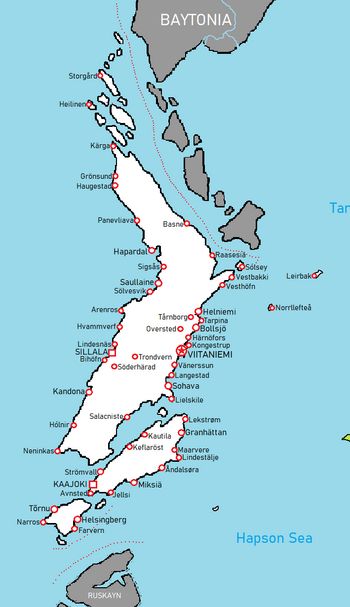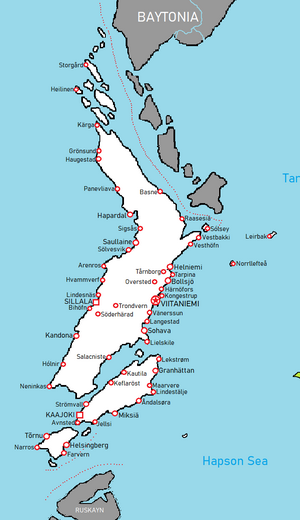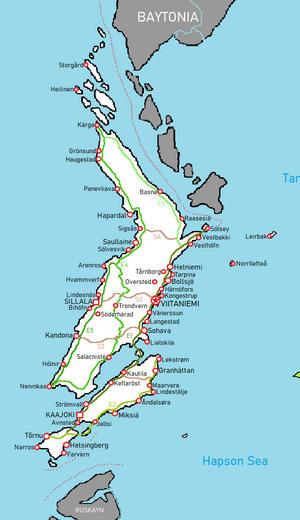Caspia
Kingdom of Caspiaa Caspiaa | |
|---|---|
|
Flag | |
 | |
| Capital | Viitaniemi |
| Government | Unitary parliamentary constitutional monarchy |
• Monarchy | Oliver Lindholm |
| Tullia Grönberg | |
| Nikolai Bjornson | |
| Mathias Ronning | |
| Niklas Frandsen | |
| Area | |
• | 385,207 km2 (148,729 sq mi) |
| Population | |
• 2020 estimate | 26,342,000 |
| GDP (PPP) | estimate |
• Total | 650 billion |
• Per capita | 64,856 |
| GDP (nominal) | estimate |
• Total | 666 billion |
• Per capita | 67,987 |
| Gini | 24.8 low |
| HDI | 0.957 very high |
| Currency | Crona |
| Date format | mm-dd-yyyy |
The Kingdom of Caspiaa, more commonly known as Caspiaa, is an archipelagic nation in northwestern Euronia, sharing maritime borders with Zamastan, Ruskayn, Karnaim, and Baytonia. The climate is in general mild due to significant maritime influence. Caspiaa often has warm continental summers, being located in between the Olympic Ocean, the Tarin and Kasuum seas, and the vast Euronian landmass. The general climate and environment varies significantly from the south and north due to the vast latitudal difference and much of Caspiaa has reliably cooler and occassionally snowy winters. Southern Caspiaa is predominantly agricultural, while the north is heavily forested and includes the Taspirian Mountains. Its capital and largest city is Viitaniemi, with other cities including Sillala, Kaajoki, Helniemi, Hapardal, Kandona, Granhättan, Tõrnu, and Saullaine.
Euronian peoples have inhabited Caspiaa since prehistoric times, emerging into history and constituting the sea peoples known as the Ascomanni. An independent Caspiaan state emerged during the early 12th century. After the Black Plague in the middle of the 14th century killed about a third of the population, the Ruskaynian League threatened Caspiaa's culture, finances and languages. When Caspiaa became involved in regional wars, an expansion of its territories began and eventually the Caspiaan Empire was formed. This became one of the great powers of western Euronia until the late 16th century, when it was conquered by the Skith Empire. The nation regained independence in 1813, and remained strategically isolated from world events, not participating in foriegn wars and instead resorting to neutrality through economics. The last war in which Caspiaa was directly involved was in 1949-54, when Caspiaa joined the allies during the World War. Since then, Caspiaa has been at peace, maintaining an official policy of neutrality in foreign affairs. Caspiaa was formally neutral through late 20th/early 21st century tensions, albeit Caspiaa has since 2009 openly moved towards cooperation with the C.C.A. and regional defense treaties with Zamastan, Rio Palito, Ruskayn, and Quetana through the Western Euronia Defense Alliance.
Caspiaa is a constitutional monarchy and a parliamentary democracy, with Legislative power vested in the 419-member unicameral legislature. It is a unitary state, currently divided into 32 counties and 96 municipalities. Caspiaa maintains a social welfare system that provides universal health care and tertiary education for its citizens. It has one of the world's highest per capita income and ranks very highly in quality of life, health, education, protection of civil liberties, economic competitiveness, income equality, gender equality, prosperity and human development. It is a member of the Coalition of Crown Albatross, WEDA, Coalition Trade Organization, C21, and the Trilateral Strategic Security Dialogue.
History
Bronze Era
Between 3000 and 2500 BC, new settlers arrived in eastern Caspiaa. They were Euronian and Adulan farmers who grew grain and kept cows and sheep. The hunting-fishing population of the west coast was also gradually replaced by farmers, though hunting and fishing remained useful secondary means of livelihood.
From about 1500 BC, bronze was gradually introduced, but the use of stone implements continued; Caspiaa had few riches to barter for bronze goods, and the few finds consist mostly of elaborate weapons and brooches that only chieftains could afford. Huge burial cairns built close to the sea as far north as Harstad and also inland in the south are characteristic of this period. The motifs of the rock carvings differ slightly from those typical of the Stone Age. Representations of the Sun, animals, trees, weapons, ships, and people are all strongly stylized.
Thousands of rock carvings from this period depict ships, and the large stone burial monuments known as stone ships, suggest that ships and seafaring played an important role in the culture at large. The depicted ships most likely represent sewn plank built canoes used for warfare, fishing and trade. These ship types may have their origin as far back as the neolithic period and they continue into the Pre-Skithan Iron Age, as exemplified by the Hjortspring boat.
Ascomanni Era
From the 8th to the 10th century, the wider Caspiaan region was the source of Ascomanni. The looting of the monastery at Barisfarne in Northeast Ruskayn in 793 by Caspiaan people has long been regarded as the event which marked the beginning of the Ascomanni Era. This age was characterised by expansion and emigration by Ascomanni seafarers. They colonised, raided, and traded in all parts of Western Euronia. Caspiaan Ascomanni explorers established colonies in Baytonia, Ruskayn, Gladysynthia, Zamastan, Arenoran Isles, Ivite, Saint Offeat, and Elbresia. The Ascomanni from Caspiaa were most active in the northern Ruskaynian islands and western Gladysynthian shores.
According to tradition, Ekyial Fairhana unified them into one in 872 after the Battle of Casfjord, thus becoming the first king of a united Caspiaa. Ekyial's realm was mainly a South Caspiaan coastal state. Fairhana ruled with a strong hand and according to the sagas, many Caspiaans left the country to live in Ruskayn and parts of Gladysynthia and Baytonia. The modern-day cities of Thornharbor (Gladysynthia), Portapique (Zamastan), and Vepovo (Saint Offeat) were founded by Caspiaan settlers.
Ascomanni traditions were replaced slowly by Christian ones in the late 10th and early 11th centuries. One of the most important sources for the history of the 11th century Rikings is the treaty between the Ruskaynians and Olaf Haraldsson, king of Caspiaa circa 1015 to 1028. This is largely attributed to the missionary king Olav Aggvasson.
Feudalism never really developed in Caspiaa, as it did in the rest of eastern Adula and Western Gladysynthia. However, the administration of government took on a very conservative feudal character. The Caseatic League forced the royalty to cede to them greater and greater concessions over foreign trade and the economy. The League had this hold over the royalty because of the loans the Ascomanni had made to the royalty and the large debt the kings were carrying. The League's monopolistic control over the economy of Caspiaa put pressure on all classes, especially the peasantry, to the degree that no real burgher class existed in Caspiaa.
Caspiaan Empire
1100-1540
Saint Offeatean settlement
1540-1620
Skith Colonization
1620-1813
Independence
1813
Modern Day
21st Century
Geography
Climate
Fauna
Demographics
Religion
Language
Cities
See also: Cities in Caspiaa
|
Metropolitan areas in Caspiaa | |||||
| No. | CMA City |
Population | |||
| 1 | Viitaniemi | 2,432,000 | |||
| 2 | Sillala | 1,544,000 | |||
| 3 | Kaajoki | 1,104,000 | |||
| 4 | Helniemi | 948,000 | |||
| 5 | Granhättan | 694,000 | |||
| 6 | Kandona | 587,000 | |||
| 7 | Tõrnu | 468,000 | |||
| 8 | Miksiä | 323,000 | |||
| 9 | Hapardal | 289,000 | |||
| 10 | Saullaine | 174,000 | |||
Politics
Monarchy
Caspiaa is a constitutional monarchy, and King Oliver Lindholm is the head of state (following the passing of his father, King Adrian Lindholm, in April of 2021), but the role of the monarch is limited to ceremonial and representative functions. Under the provisions of the Instrument of Government, the King lacks any formal political power. The King opens the annual legislative session, chairs the Special Council held during a change of Government, holds regular Information Councils with the Prime Minister and the Government, chairs the meetings of the Advisory Council on Foreign Affairs, and receives Letters of Credence of foreign ambassadors to Caspiaa and signs those of Caspiaan ambassadors sent abroad. In addition, the King pays State Visits abroad and receives those incoming as host. Apart from strictly official duties, the King and the other members of Royal Family undertake a variety of unofficial and other representative duties within Caspiaa and abroad.
Legislature
Legislative power is vested in the unicameral legislature, the Parliament of Caspiaa, with 419 members. General elections are held every four years, on the second Sunday of June. Legislation may be initiated by the Government or by members of the legislature. Members are elected on the basis of proportional representation to a four-year term. The internal workings of the legislature are, in addition to the Instrument of Government, regulated by the Hapardal Act. The fundamental laws can be altered by the legislature alone; only an absolute majority with two separate votes, separated by a general election in between, is required.
The Government operates as a collegial body with collective responsibility and consists of the Prime Minister of Caspiaa — appointed and dismissed by the Speaker of the Legislature (following an actual vote in the legislature before an appointment can be made) — and other cabinet ministers, appointed and dismissed at the sole discretion of the Prime Minister. The Government is the supreme executive authority and is responsible for its actions to the legislature. The current Prime Minister is Tullia Grönberg.
Ministers
Most of the State administrative authorities report to the Government, including (but not limited to) the Armed Forces, the Enforcement Authority, the National Library, the Caspiaan police and the Tax Agency. A unique feature of Caspiaan State administration is that individual cabinet ministers do not bear any individual ministerial responsibility for the performance of the agencies within their portfolio; as the director-generals and other heads of government agencies reports directly to the Government as a whole; and individual ministers are prohibited to interfere; thus the origin of the pejorative in Caspiaan political parlance term ministerial rule in matters that are to be handled by the individual agencies, unless otherwise specifically provided for in law.
Judiciary
The Judiciary is independent from the legislature, Government and other State administrative authorities. The role of judicial review of legislation is not practised by the courts; instead, the Council on Legislation gives non-binding opinions on legality. There is no stare decisis in that courts are not bound by precedent, although it is influential.
Foreign relations
Caspiaa maintains embassies in 82 countries. 60 countries maintain an embassy in Caspiaa, all of them in the capital, Viitaniemi.
Caspiaa is a founding member of the Coalition of Crown Albatross, Western Euronia Defense Alliance, Coalition Trade Organization, and Trade and Infrastructure Development Initiative.
Military
The Caspiaan Armed Forces numbers about 125,000 personnel, including civilian employees. According to 2019 mobilization plans, full mobilization produces approximately 183,000 combatant personnel. Caspiaa has conscription (including 6–12 months of training); in 2013, the country became the first in Euronia and WEDA to draft women as well as men. However, due to less need for conscripts after the World War, few people have to serve if they are not motivated. The Armed Forces are subordinate to the Caspiaan Ministry of Defense. The Commander-in-Chief is King Oliver Lindholm. The military of Caspiaa is divided into the following branches: the Caspiaan Army, the Royal Caspiaan Navy, the Royal Caspiaan Air Force, and the Home Guard.
The country was one of the founding nations of the Western Euronia Defense Alliance (WEDA) on March 29th, 2001. At present, Caspiaa contributes in several peacekeeping missions around the globe.
Culture
Human rights
Cinema
- Counterfeit (2022)
- Merhaba Komsu (Hello Neighbour)
- Legend of the Fox (2024)
- Bishop of the Sun (2024)
- Endless Run (2024)
- I am a Royal Soldier (2024)
Art
Music
Literature
Cuisine
Sports
Association football is the most popular sport in Caspiaa, regulated by the Caspiaan Football Federation with the top league in Caspiaa being the Premier Caspiaa League. The national football team is one of the top ranked teams in international competitions, often performing well in the EFC Nations League and the World Cup. Caspiaa's professional football players are highly sought after by foreign clubs. Caspiaa won the 1979 World Cup and has hosted twice, in 2002 and 2024.
Economy
Caspiaans enjoy one of the the highest GDPs per-capita among Euronian countries, and the sixth-highest GDP (PPP) per-capita in the world. Today, Caspiaa ranks as the second-wealthiest country in the world in monetary value, with the largest capital reserve per capita of any nation. Caspiaa maintained first place in the world in the Human Development Index (HDI) for six consecutive years (2001–2006), and then reclaimed this position in 2009. The standard of living in Caspiaa is among the highest in the world.
The Caspiaan economy is an example of a mixed economy; a prosperous capitalist welfare state it features a combination of free market activity and large state ownership in certain key sectors, influenced by both liberal governments from the late 19th century and later by social democratic governments in the post-World War era. Public health care in Caspiaa is free (after an annual charge of around 2000 kroner for those over 16), and parents have 46 weeks paid parental leave. The state income derived from natural resources includes a significant contribution from petroleum production. Caspiaa has an unemployment rate of 4.8%, with 68% of the population aged 15–74 employed. People in the labor force are either employed or looking for work. 9.5% of the population aged 18–66 receive a disability pension and 30% of the labor force are employed by the government. The hourly productivity levels, as well as average hourly wages in Caspiaa, are among the highest in the world.
The country is richly endowed with natural resources including petroleum, hydropower, fish, forests, and minerals. Large reserves of petroleum and natural gas were discovered in the 1960s, which led to a boom in the economy. Caspiaa has obtained one of the highest standards of living in the world in part by having a large amount of natural resources compared to the size of the population. In 2011, 28% of state revenues were generated from the petroleum industry.
Caspiaa is the first country which banned cutting of trees (deforestation), in order to prevent rain forests from vanishing. The country declared its intention at the CCA Climate Summit in 2014, alongside Saint Offeat and Kyti. Crops, that are typically linked to forests' destruction are timber, soy, palm oil and beef. Now Caspiaa has to find a new way to provide these essential products without exerting negative influence on its environment.
Wilberg Lines is a major shipping company.
Resources
Export revenues from oil and gas have risen to over 40% of total exports and constitute almost 20% of the GDP. Caspiaa is one of the largest oil exporters and gas exporters in the world. In 1995, the Caspiaan government established the sovereign wealth fund ("Government Pension Fund – Global"), which would be funded with oil revenues, including taxes, dividends, sales revenues and licensing fees. This was intended to reduce overheating in the economy from oil revenues, minimize uncertainty from volatility in oil price, and provide a cushion to compensate for expenses associated with the ageing of the population. The government controls its petroleum resources through a combination of state ownership in major operators in the oil fields (with approximately 62% ownership in Casoil in 2007) and the fully state-owned PetroCaspiaa. Finally, the government controls licensing of exploration and production of fields. The fund invests in developed financial markets outside Caspiaa. Spending from the fund is constrained by the budgetary rule, which limits spending over time to no more than the real value yield of the fund, originally assumed to be 4% a year, but lowered in 2017 to 3% of the fund's total value.
Between 1966 and 2013, Caspiaan companies drilled 5085 oil wells, mostly in the Tarin Sea and Olympic Ocean. Of these 3672 are regular production; 1413 are exploration; and 1405 have been terminated.
Caspiaa is also one of the world's largest exporter of fish. Fish from fish farms and catch constitutes the second largest (behind oil/natural gas) export product measured in value.
Hydroelectric plants generate roughly 98–99% of Caspiaa's electric power, more than any other country in the world.
Caspiaa contains significant mineral resources. The most valuable minerals are calcium carbonate (limestone), building stone, nepheline syenite, olivine, iron, titanium, and nickel.
Transport

Due to the low population density, narrow shape and long coastlines of Caspiaa, its public transport is less developed than in many Euronian countries, especially outside the major cities. The country has long-standing water transport traditions, but the Caspiaan Ministry of Transport and Communications has in recent years implemented rail, road, and air transport through numerous subsidiaries to develop the country's infrastructure. Under discussion is development of a new high-speed rail system between the nation's largest cities.
There are three tiers of road routes in Caspiaa - national, municipal, and private. The national routes are the most prominent networks which expand across the country. E numbered routes go north to south, while S numbered routes run east to west, connecting to the adjacent E routes. The national roads are as follows;
- E1 - Tõrnu to Sólsey
- E2 - Tõrnu to Lekstrøm
- E3 - Vesthöfen to Kärga
- E4 - Neninkas to Kärga
- E5 - Neninkas to Arenros
- S1 - Kautila to Granhättan
- S2 - Kandona to Sohava
- S3 - Sillala to Viitaniemi
- S4 - Sigsâs to Vesthöfen










